伦敦城市建设史PPT课件
- 格式:ppt
- 大小:6.44 MB
- 文档页数:25

伦敦的历史如何?伦敦作为英国的首都,其历史悠久且充满了传奇色彩。
下面将从城市建设、文化遗产、历史事件等角度,为大家详细介绍伦敦的历史。
一、城市建设1. 罗马时期:公元43年,罗马人入侵不列颠岛,开始了罗马统治时期。
此时,伦敦成为罗马人的重要城市,开始了城市建设。
当时的伦敦城主要是中央市场、浴场、寺庙等公共建筑。
2. 中世纪:中世纪时期,伦敦城逐渐发展为一个重要的商业中心。
当时的伦敦桥、泰晤士河畔码头等建筑都可以追溯到这个时期。
3. 工业革命:工业革命时期,伦敦开始向现代化城市转型。
人口急剧增长,城市建设也不断扩张。
此时期的伦敦塔桥、大英博物馆等建筑至今仍是伦敦的标志性建筑。
二、文化遗产1. 文艺复兴时期:文艺复兴时期,伦敦逐渐成为艺术中心。
当时的莎士比亚、伦勃朗等文化名人都居住在伦敦,并为伦敦的文化注入了新的活力。
伦敦的国家美术馆、国王剧院等文化场所都可以追溯到这个时期。
2. 维多利亚时期:维多利亚时期是伦敦文化发展的关键时期。
当时的维多利亚女王将伦敦建设成为一个世界级的文化城市,在伦敦建设了许多文化场馆,例如维多利亚与艾伯特博物馆、英国博物馆等。
3. 现代:现代伦敦文化以多元化著称。
伦敦艺术节、伦敦时装周、艺术跨界展等各种文化活动不断涌现,并让伦敦成为一个国际性的文化中心。
三、历史事件1. 大火:1666年的伦敦大火是伦敦历史上最为严重的火灾。
大火造成了13万人无家可归,同时也促使了伦敦的城市重建。
2. 雾都伦敦:19世纪末,伦敦曾经被一连串的雾霾天气所笼罩,被称为雾都伦敦。
当时的雾霾非常严重,不仅影响了城市居民的健康,也引起了社会各界的关注。
3. 7.7爆炸:2005年7月7日,伦敦发生了恐怖袭击事件,当时的地铁、公交车等交通工具都被炸毁。
此次爆炸事件造成了52人死亡,700多人受伤。
以上就是伦敦的历史概述。
伦敦作为一个拥有千年历史的城市,在不断变化中仍然保留着自己的文化和传统,也在不断向新时代迈进。

城市传奇英国伦敦的历史演变伦敦是世界上历史最悠久、最繁忙的城市之一。
它作为英国的首都,拥有悠久而丰富的历史背景,吸引着无数游客和历史爱好者。
在伦敦的历史演变中,它经历了许多重大的事件和发展阶段。
下面将以时间顺序为线索,简要介绍伦敦的历史演变。
1. 罗马时期(43年-410年)公元43年,罗马人征服了这片土地,建立了一座名为“伦敦尼乌姆(Londinium)”的城市。
伦敦成为了罗马在不列颠最重要的城市之一,是政治、商业和文化的中心。
罗马人在伦敦建造了大量的建筑物和道路,包括著名的伦敦塔。
然而,罗马在公元410年撤离不列颠后,伦敦开始经历一段不稳定的时期。
2. 中世纪时期(11世纪-16世纪)在中世纪时期,伦敦重新发展起来,并逐渐成为英格兰最重要的城市。
威廉一世于1066年征服了英格兰,将伦敦作为政治和行政中心。
在这个时期,伦敦逐渐建立了自己的城市规划和组织。
大教堂、城堡和市政厅被兴建起来,如圣保罗大教堂和伦敦桥等便是中世纪建筑的代表。
14世纪末,伦敦开始遭受黑死病的破坏,但城市很快恢复,并迎来了繁荣的时期。
伦敦金融和商业业务的发展打造了一个富裕的城市,将伦敦建设成为重要的贸易中心。
同时,威斯敏斯特宫的建造也使伦敦成为英国的政治中心。
3. 十七世纪的大火(1666年)1666年,伦敦遭受了一场毁灭性的大火,几乎烧毁了整个城市。
这场大火迫使人们重新考虑城市的建设和安全问题。
大火后,伦敦开始重建,克里斯托弗·雷恩设计了一份新的城市规划方案,包括宽敞的街道和防火建筑。
4. 工业革命(18世纪)工业革命的到来使伦敦发生了巨大的变化。
城市的人口急剧增长,工厂和工业企业如雨后春笋般涌现。
伦敦成为贫富差距最大的城市之一,城市中心的贵族和富商伫立在笼罩着煤烟的工业区旁边。
同时,城市的发展也带来了一系列的社会问题,如贫民窟和社会不平等。
5. 第二次世界大战(1939年-1945年)第二次世界大战期间,伦敦成为纳粹轰炸的目标之一。
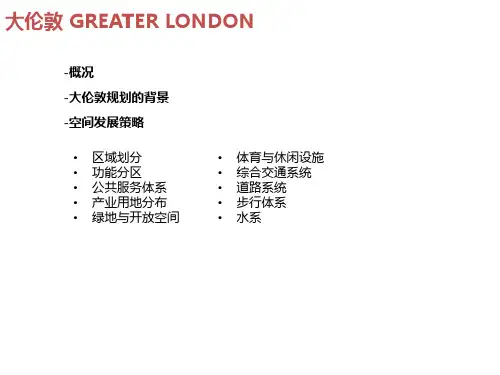


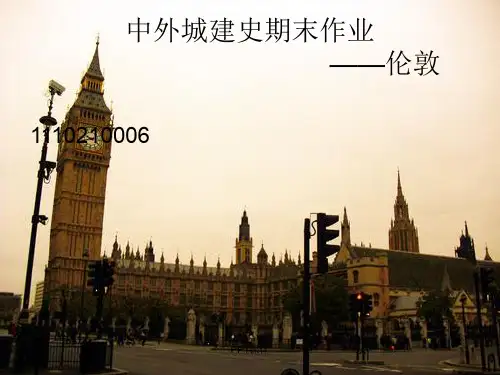
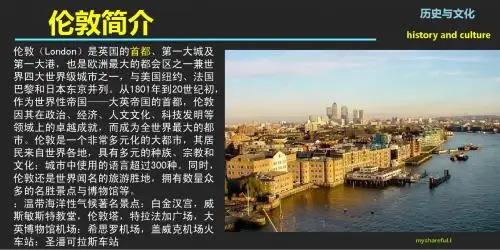

伦敦城市规划摘要:伦敦作为世界级大城市之一,其城市规划可作为城市规划典例供如今探讨,本文主要简要分析伦敦城市发展状况及大伦敦地区的城市规划的内容,影响以及问题等等。
关键词:伦敦;大伦敦;规划;交通;布局;改建;影响;伦敦是英国政治、经济、文化以及交通的中心,最大海港和首要工业城市,世界十大都市之一。
它位于英格兰东南部,跨泰晤士河下游两岸,距河口88公里。
伦敦市城外的12个市区,称内伦敦,以外的20个市区,称外伦敦。
伦敦城加上内外伦敦,合称大伦敦市,面积1580平方公里。
历史上伦敦曾是罗马帝国的巡省,其建筑风格首先受到了罗马建筑风格的影响;此外,工业革命率先在英国发生,对城市的发展产生深远影响,成为伦敦进入现代城市的转折点;第三,伦敦是一个岛国城市,而非大陆城市,海外贸易的发展使其具有全球视野,因此它比大陆城市还要开放;第四,伦敦的建筑特色还打上了盎格鲁—撒克逊民族文化的烙印。
现代的伦敦作为一个世界级城市,在经济、政治文化、交通运输等方面的世界地位是极高的。
漫步伦敦老城区,游客很少会看到宽阔、豪华、现代化的门廊,但古典、高贵的气质却从屋檐上一处石头雕塑、窗口挂着的蕾丝窗帘、大厅里悬挂的水晶吊灯上流露出来。
一打听,你也许会突然发现,这里就是英国女王钟爱的用下午茶的最佳去处,那里曾经住过一个历史上非常有名的公爵……似乎每一块砖头后面都藏着一个故事,无声地彰显出历史的厚重感。
伦敦向世界大城市展示了这样一个理念:传统与现代化并不是格格不入。
我觉得这种规划理念恰恰是我们当今的城市规划所需要的。
大伦敦地区城市规划:随着伦敦城市聚集效应的影响逐渐扩大,对周边地区的影响产生了“大伦敦”地区的概念。
大伦敦包括伦敦城、内伦敦和外伦敦,共1580平方公里,共有33个区,其中伦敦城是核心区,面积只有1.6平方公里。
大伦敦由内向外划分为四层地域圈:内圈、近郊圈、绿带圈、外圈。
大伦敦的规划结构为单中心同心圆封闭式系统,其交通组织采取放射路与同心环路直交的交通网。

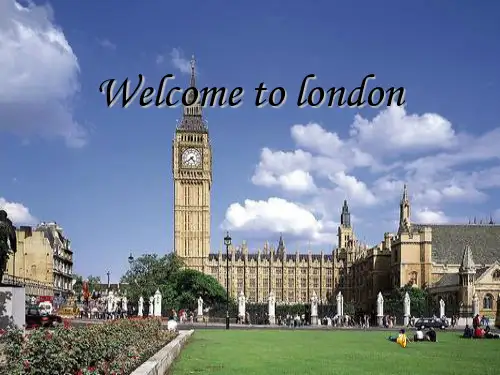
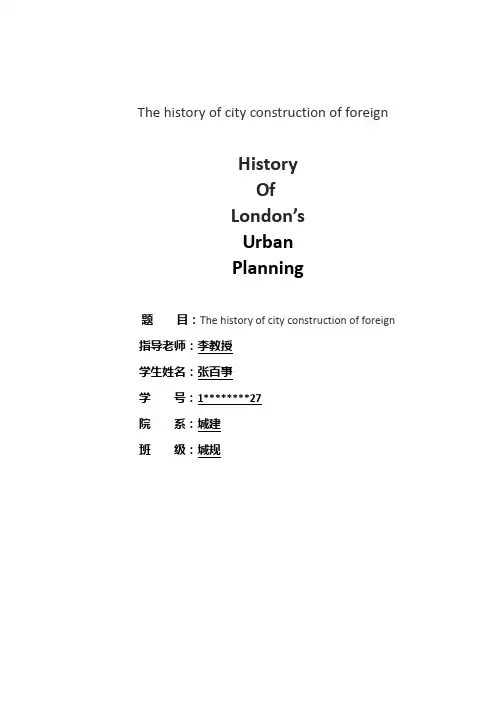
The history of city construction of foreignHistoryOfLondon’sUrbanPlanning题目:The history of city construction of foreign 指导老师:李教授学生姓名:张百事学号:1********27院系:城建班级:城规History of London’s planningAbstractLondon, the capital city of England and the United Kingdom, has a history dating back over 2,000 years. During this time, it has grown to become one of the most significant financial and cultural capitals of the world.London has grown into metropolitan area in this years, no longer is the history of the Greater London. It is difficult to imagine London, was once a small town.Table of ContentsAbstractChapter One Introduction1.1Background of the ResearchChapter Two history of London2.1. Norman and Medieval London (1066 – late 15th century)2.2. Tudor London (1485–1603)2.3. Stuart London (1603–1714)2.4. 19th-century LondonChapter Three3.1. ConclusionBibliographyChapter One1.1 Background of the ResearchLondon is the capital city of England and the United Kingdom. It is the most populous city in the United Kingdom, with an urban area of over 9 million inhabitants. Standing on the River Thames, London has been a major settlement for two millennia, largely retains its 2.9 km2 mediaeval boundaries and in 2011 had a resident population of 7,375, making it the smallest city in England. Since at least the 19th century, the term London has also referred to the metropolis developed around this core.[1]London is leading global city.[2][3] with strengths in the arts, commerce, education, entertainment, fashion, finance, healthcare, media, professional services, research and development, tourism, and transport all contributing to its preeminence. It is one of the world's leading financial centres and has the fifth-or sixth-largest metropolitan area GDP in the world depending on measurement. London is a world cultural capital. It is the world's most-visited city as measured by international arrivalsand has the world's largest city airport system measured by passenger traffic.Area• Region 606.95 sq mi(1,572.00 km2)• Urban 671.0 sq mi (1,737.9 km2)• Metro 3,236.31 sq mi (8,382.00 km2)Elevation 115 ft (35 m)Population (2013)• Region 8,416,535• Density 13,870/sq mi (5,354/km2)• Urban 9,787,426• Metro 13,614,409Chapter Two2.1 Norman and Medieval LondonThe Establishment of the Kingdom of England in 1284 A.D. London is the capital city of England and it’s about 2 sq km in the 1300 A.D., it is a walk city, and Located in the River Thames. England is an island country, London has enough water.In 1100 London's population was somewhat more than 15,000. By 1300 A.D. it had grown to roughly 80,000. London lost at least half of its population during the Black Death in the mid-14th century, but its economic and political importance stimulateda rapid recovery despite further epidemics. Trade in London was organised into various guilds, which effectively controlled the city, and elected the Lord Mayor of the City of London.[4] The Europeans have not boiling water, it is a reason In some ways Led to the Black Death.2.2. Tudor London (1485–1603)In 1593 A.D. to 1605 A.D. , London still is a small town. The slow development of London in this time, London from 4 sq km to 5 sq km.During the Reformation, London was the principal early centre of Protestantism in England. Its close commercial connections with the Protestant heartlands in northern continental Europe, large foreign mercantile communities, disproportionately large number of literate inhabitants and role as the centre of the English print trade all contributed to the spread of the new ideas of religious reform. Before the Reformation, more than half of the area of London was the property of monasteries, nunneries and other religious houses.[5]For city development, religion plays a dominant role, the church is the center of the city.2.3. Stuart London (1603–1714)Tudor London developed to Stuart London, the Handicraftsman became the leading city.London's expansion beyond the boundaries of the City was decisively established in the 17th century. In the opening years of that century the immediate environs of the City, with the principal exception of the aristocratic residences in the direction of Westminster, were still considered not conducive to health.In Britain it is the last major outbreak which is remembered as the "Great Plague" It occurred in 1665 and 1666 and killed around 60,000 people, which was one fifth of the population. Samuel Pepys chronicled the epidemic in his diary. On 4 September 1665 he wrote "I have stayed in the city till above 7400 died in one week, and of them about 6000 of the plague, and little noise heard day or night but tolling of bells."[6]What’s a pity about Great Fire of London (1666), but it’s also w aking up people to think about the meaning of the city. John Evelyn's plan for the rebuilding of London after the Great Fire.The first industrial revolution in Britain in 18 Century 60-19 century 40's.London developed into an industrial city, the British economy more and more prosperous.2.4. 19th-century LondonDuring the 19th century, London was transformed into the world's largest city and capital of the British Empire. Its population expanded from 1 million in 1800 to 6.7 million a century later. During this period, London became a global political, financial, and trading capital. In this position, it was largely unrivalled until the latter part of the century, when Paris and New York began to threaten its dominance.At the time, raw sewage was pumped straight into the River Thames. This culminated in The Great Stink of 1858.Parliament finally gave consent for the MBW to construct a large system of sewers. The engineer put in charge of building the new system was Joseph Bazalgette. In what was one of the largest civil engineering projects of the 19th century, he oversaw construction of over 2100 km of tunnels and pipes under London to take away sewage and provide clean drinking water. When the London sewerage system was completed, the death toll in London dropped dramatically, and epidemics of cholera and other diseases were curtailed. Bazalgette's system is still in use today. [7] In London, people will put the "fog" of the title and it connects. Indeed beforethe last century 60's, called London fog is known to the world. London smog, confused. Although the street lamp is bright, but the visibility is still poor, not see anything other than 10 meters. Always feel vaguely in front of people. But now, over London has been basically rarely seen the billowing smoke and diffuse yellow fog.The rapid development of industry, has brought the city population increase, other parts of the people working in London, resulting in excessive population density.GARDEN CITIES OF TO-MORROW was be written by EbenezerHoward in 1898, he was thinking the size of the city, the relationship between the town and country, the city should not be unlimited expansion,Chapter Three3.1. ConclusionWhen the city was expending, some problems came together, the population rises so fast, air and water got serious pollutant, and traffic congestion. City to develop must pay a price.City can’t be like to share the same pie, unlimited expansion, causing trafficCongestion.City planners should improve the quality of city living.London is a metro urban in today, it is one of the world's leading financial centres.Bibliography1."Roman London". Museum of London. n.d. Archived from the original on 22 June 2008.2."The Most Dynamic Cities of 2025". Foreign Policy. September–October 2012. Retrieved28 September 2012.3.Jump up^ "Global city GDP rankings 2008–2025".4.Wikipedia, https:///wiki/Norman_and_Medieval_London5.Wikipedia, https:///wiki/Tudor_London6.Wikipedia, https:///wiki/Great_Fire_of_London7.Wikipedia, https:///wiki/19th-century_London。
传统与现代化并非格格不入漫步伦敦老城区,游客很少会看到宽阔、豪华、现代化的门廊,但古典、高贵的气质却从屋檐上一处石头雕塑、窗口挂着的蕾丝窗帘、大厅里悬挂的水晶吊灯上流露出来。
一打听,你也许会突然发现,这里就是英国女王钟爱的用下午茶的最佳去处,那里曾经住过一个历史上非常有名的公爵……似乎每一块砖头后面都藏着一个故事,无声地彰显出历史的厚重感。
和一些新兴国家的人痴迷于新设施不同,在英国似乎是历史越悠久的房子价值越高,老房子流露出的古典气息在很多人眼里恰恰是贵族身份的象征。
伦敦的面孔并不是单一的,而是由多种元素聚合而成的。
提到伦敦的怀旧风情,人们想到的不仅仅是老建筑,还有独具特色的交通工具和市政设施。
红色的电话亭、黑色老爷车样式的出租汽车,点缀在古老的街头巷尾之间是那样相得益彰。
根据这些造型设计的旅游纪念品,比如钥匙链、茶叶盒,也是深受旅游者喜爱的纪念品,如此独特的设计俨然已经成为了伦敦的符号。
伦敦全城没有摩天大楼,房屋大多只有四五层,高的十来层,最高的楼仅有二三十层,且寥寥无几。
除了古旧的建筑,伦敦拥有620多个文化设施,上百家公园和四通八达的交通。
伦敦市中心的街道狭窄、曲折,尽管交通拥堵一直是令市政府头疼的事情,但将老建筑推倒以拓宽马路并不在政府的计划之内。
车辆进入伦敦中心地带被严格控制,收取高昂的进城费,发达的地铁设施在很大程度上缓解了伦敦的交通压力。
去年,伦敦市政府曾经有计划仿效纽约在市中心建造多座摩天大楼,但是遭到多数民众的强烈反对,而他们反对的原因是担心这些摩天大楼会掩盖白金汉宫、大英博物馆的光芒,使这些历史建筑存在于现代化的阴影之下。
最终伦敦市政府不得不宣布放弃这项计划。
英国人并不羡慕生活在高楼大厦之中,享受久远历史带给自己生活的乐趣才是这个岛国民众的追求。
伦敦也并不是没有现代建筑,站在泰晤士河边沿河望去,吸引了众多游人的摩天轮“伦敦眼”、全钢结构的“千年桥”、螺旋式外观的瑞士再保险公司总部大楼等摩登建筑就会映入你的眼帘。